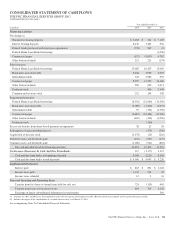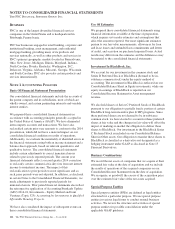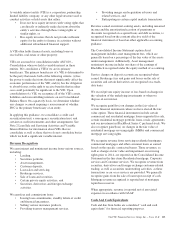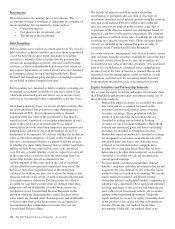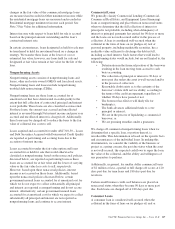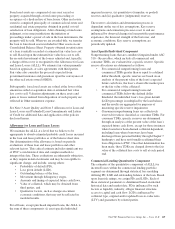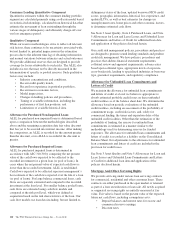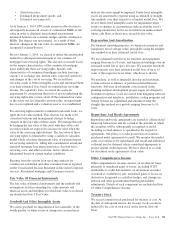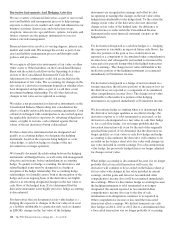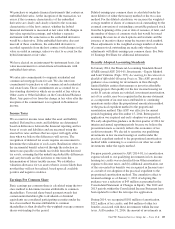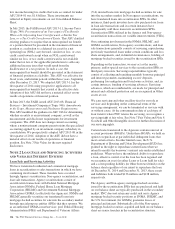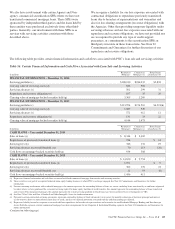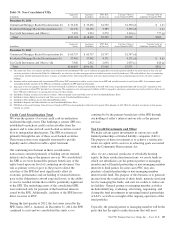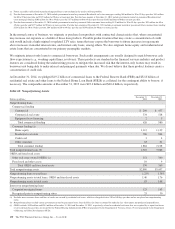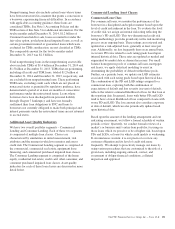PNC Bank 2014 Annual Report Download - page 139
Download and view the complete annual report
Please find page 139 of the 2014 PNC Bank annual report below. You can navigate through the pages in the report by either clicking on the pages listed below, or by using the keyword search tool below to find specific information within the annual report.
• Stated note rates,
• Estimated prepayment speeds, and
• Estimated servicing costs.
As of January 1, 2014, PNC made an irrevocable election to
subsequently measure all classes of commercial MSRs at fair
value in order to eliminate any potential measurement
mismatch between our economic hedges and the commercial
MSRs. The impact was not material. As a result of that
election, changes in the fair value of commercial MSRs are
recognized as gains/(losses).
Prior to January 1, 2014, we elected to utilize the amortization
method for subsequent measurement of our commercial
mortgage loan servicing rights. This election was made based
on the unique characteristics of the commercial mortgage
loans underlying these servicing rights. Specific risk
characteristics of commercial mortgages include loan type,
currency or exchange rate, interest rates, expected cash flows
and changes in the cost of servicing. We record these
servicing assets as Other intangible assets and amortized them
over their estimated lives based on estimated net servicing
income. On a quarterly basis, we tested the assets for
impairment by categorizing the pools of assets underlying the
servicing rights into various strata. If the estimated fair value
of the assets was less than the carrying value, an impairment
loss was recognized and a valuation reserve was established.
For servicing rights related to residential real estate loans, we
apply the fair value method. This election was made to be
consistent with our risk management strategy to hedge
changes in the fair value of these assets. We manage this risk
by hedging the fair value of this asset with derivatives and
securities which are expected to increase in value when the
value of the servicing right declines. The fair value of these
servicing rights is estimated by using a cash flow valuation
model which calculates the present value of estimated future
net servicing cash flows, taking into consideration actual and
expected mortgage loan prepayment rates, discount rates,
servicing costs, and other economic factors which are
determined based on current market conditions.
Revenue from the various loan servicing contracts for
commercial, residential and other consumer loans is reported
on the Consolidated Income Statement in line items Corporate
services, Residential mortgage and Consumer services.
Fair Value Of Financial Instruments
The fair value of financial instruments and the methods and
assumptions used in estimating fair value amounts and
financial assets and liabilities for which fair value was elected
are detailed in Note 9 Fair Value.
Goodwill And Other Intangible Assets
We assess goodwill for impairment at least annually, in the
fourth quarter, or when events or changes in circumstances
indicate the assets might be impaired. Finite-lived intangible
assets are amortized to expense using accelerated or straight-
line methods over their respective estimated useful lives. We
review finite-lived intangible assets for impairment when
events or changes in circumstances indicate that the asset’s
carrying amount may not be recoverable from undiscounted
future cash flows or that it may exceed its fair value.
Depreciation And Amortization
For financial reporting purposes, we depreciate premises and
equipment, net of salvage value, principally using the straight-
line method over their estimated useful lives.
We use estimated useful lives for furniture and equipment
ranging from one to 10 years, and depreciate buildings over an
estimated useful life of up to 40 years. We amortize leasehold
improvements over their estimated useful lives of up to 15
years or the respective lease terms, whichever is shorter.
We purchase, as well as internally develop and customize,
certain software to enhance or perform internal business
functions. Software development costs incurred in the
planning and post-development project stages are charged to
Noninterest expense. Costs associated with designing software
configuration and interfaces, installation, coding programs and
testing systems are capitalized and amortized using the
straight-line method over periods ranging from one to 10
years.
Repurchase And Resale Agreements
Repurchase and resale agreements are treated as collateralized
financing transactions and are carried at the amounts at which
the securities will be subsequently reacquired or resold,
including accrued interest, as specified in the respective
agreements. Our policy is to take possession of securities
purchased under agreements to resell. We monitor the market
value of securities to be repurchased and resold and additional
collateral may be obtained where considered appropriate to
protect against credit exposure. We have elected to account
for structured resale agreements at fair value.
Other Comprehensive Income
Other comprehensive income consists, on an after-tax basis,
primarily of unrealized gains or losses, excluding OTTI
attributable to credit deterioration, on investment securities
classified as available for sale, unrealized gains or losses on
derivatives designated as cash flow hedges, and changes in
pension and other postretirement benefit plan liability
adjustments. Details of each component are included in Note
18 Other Comprehensive Income.
Treasury Stock
We record common stock purchased for treasury at cost. At
the date of subsequent reissue, the treasury stock account is
reduced by the cost of such stock on the first-in, first-out
basis.
The PNC Financial Services Group, Inc. – Form 10-K 121


